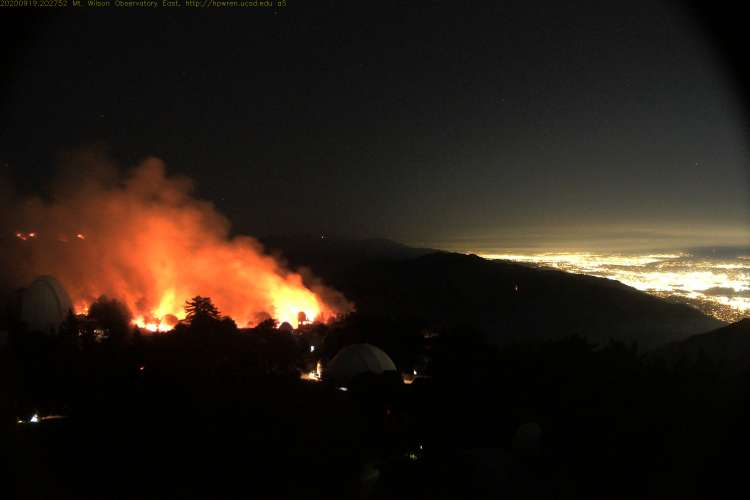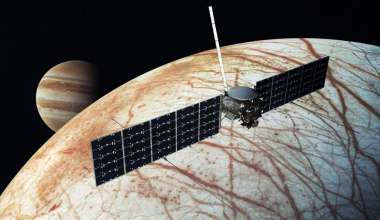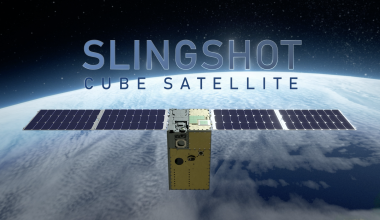As the Bobcat Fire in California burned out of control across the San Gabriel Mountains in mid-September, the blaze nearly destroyed a crucial center of astronomy – the Mount Wilson Observatory.
This important work nearly ended in the Bobcat Fire, which at times came within 100 yards of the Mt. Wilson Observatory and MAFIOT facility. Due to the heroic efforts by firefighting crews, the Observatory and MAFIOT structure survived.
“We are grateful to the firefighters who put their lives on the line to battle the fire around the facility,” said Dave Cardoza, the Principal Director of Aerospace's Electronics and Photonics Laboratory. “The fact that the structures are still standing is a testament to the dedication that they put into their jobs. This will allow us to continue our important work on the mountain.”
Video of the Bobcat Fire near the Mt. Wilson Observatory, as seen from an east pointing HPWREN camera at the Observatory on Sept. 19, showing Los Angeles in the background. [Credit: http://hpwren.ucsd.edu]
Since the early 1900s, Southern California’s Mount Wilson has played a crucial role in astronomical activity, from early telescope-aided studies of the sun to the discovery of nebulae in faraway galaxies by the famed Edwin Hubble. Situated high above the Los Angeles basin with a clear view that spans from the Pacific Ocean to the Inland Empire, Mt. Wilson continues to play an important role in advancing our understanding of space and the technologies needed to observe it.
More recently, The Aerospace Corporation furthered these efforts through work at the Mt. Wilson Aerospace Facility for Integrated Optical Tests, known as MAFIOT, by providing a unique testbed to conduct experiments. The wide range of research includes atmospheric laser propagation, atmospheric scattering, laser communications, and other laser applications. MAFIOT is designed to augment Space Domain Awareness capabilities that combine different wavelength bands of light for passive and active tracking to better characterize space objects. The project has been a cross-enterprise development with staff from Aerospace’s Physical Science Laboratories, Vehicle Systems Division and xLab working together to develop a flexible testbed that allows customers to easily test new optical sensors, innovative laser techniques, and concepts of operation for space domain awareness.
“It’s designed to be a flexible testbed that can accommodate a number of types of experiments,” said Andrew Mollner, a Project Leader at Aerospace. “We’re evaluating evolving, emerging technologies.”

The core of MAFIOT is the modular suite of instruments that include a series of cameras and their associated optics, which together are capable of capturing everything from visible light through the longwave infrared band. Depending on the experiment, different cameras, detectors and software can be integrated into the testbed, allowing for evaluation with real targets.
The Mt. Wilson location provides several benefits, including serving as a cost-effective and convenient location for electronics and photonics work compared to off-shore facilities. In addition, it is a historically great site for astronomical seeing and it provides a vantage point close to Vandenberg Air Force Base and San Nicholas Island.
MAFIOT’s flexible nature makes it a powerful tool for conducting tests for Aerospace customers. In addition to demonstrating and benchmarking technologies, Aerospace experts have also developed expertise in acquiring and analyzing the data sensors provide.
Recent work has included study of a state-of-the-art photon sensitive camera, capable of detecting single photons of light. This will be an enabling technology for optical communications. Lessons learned from Aerospace’s integration of the camera into the MAFIOT testbed, including methods for extracting data, were transferred to industry partners, saving time and cost on future systems development.
“If you want people to be doing evaluations of technologies or techniques, having the objectivity and depth of expertise that comes with what Aerospace does with a facility like this is highly valuable,” Mollner said. “We’re not trying to sell anything. We’re trying to give honest evaluations of what can be done.”
While it remains to be seen what impact the heat and smoke from the Bobcat fire will have on the equipment, the Observatory is safe for the time being. The dedicated effort of the firefighting crews saved this historic site and have allowed Aerospace to continue to work on shaping the future of Space Domain Awareness.









